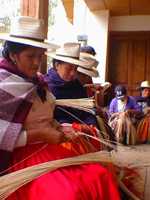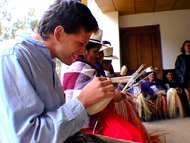|
 The small town of Sigsig, approximately 65 km north of Cuenca, is like many of the mountain towns in the southern highlands of Ecuador. The heavy production of Maiz for hundreds of years has left the tough sierra soil infertile and made the economy just as barren. In search of work, many of the men have migrated to large Ecuadorian cities, Mexico or the United States. Left in the wake of this migration are women who must not only tend to their domestic duties, but also figure out how to make a living. The small town of Sigsig, approximately 65 km north of Cuenca, is like many of the mountain towns in the southern highlands of Ecuador. The heavy production of Maiz for hundreds of years has left the tough sierra soil infertile and made the economy just as barren. In search of work, many of the men have migrated to large Ecuadorian cities, Mexico or the United States. Left in the wake of this migration are women who must not only tend to their domestic duties, but also figure out how to make a living.

  Toquilleras weaving Toquilleras weaving
at a workshop. |
However, the women of Sigsig have one advantage. Sig-sig is home to a tradition of Paja Toquilla weaving, or as they are known in the world of tourism- Panama Hats. The misnamed hat, once the choice of American soldiers and gangsters, is Ecuador's most famous export. Weavers of Panama Hats, or toquilleras as they are called in Sigsig, spend hours interlacing the fine straw threads of every hat. In order to save time, the toquilleras carry straw everywhere they go and weave constantly. Whether they are tending to domestic duties, talking with friends or walking along the road, the toquilleras are always weaving.
 Although hundreds of women in Sigsig had this marketable skill, they were unorganized, unfamiliar with larger markets and heavily exploited. Limited by the small world of Sigsig, most toquilleras were unaware of desired styles and quality standards and had little idea how much the hats were being sold for elsewhere. Of all the participants in the production and commercialization of the hats, these women, who clearly did the most painstaking and time consuming labor, received the least in compensation. The average weaver received less than a dollar for a hat that sold for $20 to $25 dollars in large Ecuadorian cities and US showrooms.
Although hundreds of women in Sigsig had this marketable skill, they were unorganized, unfamiliar with larger markets and heavily exploited. Limited by the small world of Sigsig, most toquilleras were unaware of desired styles and quality standards and had little idea how much the hats were being sold for elsewhere. Of all the participants in the production and commercialization of the hats, these women, who clearly did the most painstaking and time consuming labor, received the least in compensation. The average weaver received less than a dollar for a hat that sold for $20 to $25 dollars in large Ecuadorian cities and US showrooms.

 |

 Sam weaving with Sam weaving with
the Toquilleras |
 These tides turned with the creation of a cooperative of toquilleras called "Maria Auxilliadora" and the support of the Fundacion Esquel that followed. With financial and technical assistance from Esquel, the toquilleras were able to create a factory with modern machinery. With these new facilities, along with added commercial assistance, "Maria Auxilliadora" shed the weight of middlemen who had been eating away at their profits. They have begun to export their hats to Europe and have already sent over 6000 hats to Spain ans Switzerland. Now, over 400 women work for the cooperative, producing more than 3000 hats a week at a higher quality than they had been produced for earlier.
These tides turned with the creation of a cooperative of toquilleras called "Maria Auxilliadora" and the support of the Fundacion Esquel that followed. With financial and technical assistance from Esquel, the toquilleras were able to create a factory with modern machinery. With these new facilities, along with added commercial assistance, "Maria Auxilliadora" shed the weight of middlemen who had been eating away at their profits. They have begun to export their hats to Europe and have already sent over 6000 hats to Spain ans Switzerland. Now, over 400 women work for the cooperative, producing more than 3000 hats a week at a higher quality than they had been produced for earlier.

 |

 Natacha Reyes of esquel Natacha Reyes of esquel
talking to the toquilleras |
Besides having access to better resources and working conditions, one reason for the increased quality of the hats are workshops, sponsored by Esquel, that help the toquilleras improve on their craft. Many of the toquillleras learned how to make Panama Hats by the time they were eight years old. However, the workshop introduces them to fashionable and marketable styles with which they might not be familiar. In addition, they learn how to weave the hats so finely that they can be folded and put in a small box without loosing their shape. This durability is part of the allure to tourists and will make a more marketable product.
 The growing market awareness of "Maria Auxilliadora" has broadened the horizons of Sigsig's toquilleras in a number of ways. According to "Maria Auxilliadora" President, Rosita Aurelia, the cooperative has not only helped them to earn more for their labor, but has also created a sense of unity and self-suffiency that did not exist earlier. Even though many of their husbands have left, the toquilleras are better equipped to take care of their families and earn a living. While the toquilleras and the town of Sigsig are still poor, "Maria Auxilliadora" and the Fundacion de Esquel have begun the process of paving a road to equality along the much fabled Panama Hat Trail.
The growing market awareness of "Maria Auxilliadora" has broadened the horizons of Sigsig's toquilleras in a number of ways. According to "Maria Auxilliadora" President, Rosita Aurelia, the cooperative has not only helped them to earn more for their labor, but has also created a sense of unity and self-suffiency that did not exist earlier. Even though many of their husbands have left, the toquilleras are better equipped to take care of their families and earn a living. While the toquilleras and the town of Sigsig are still poor, "Maria Auxilliadora" and the Fundacion de Esquel have begun the process of paving a road to equality along the much fabled Panama Hat Trail.
|
|




